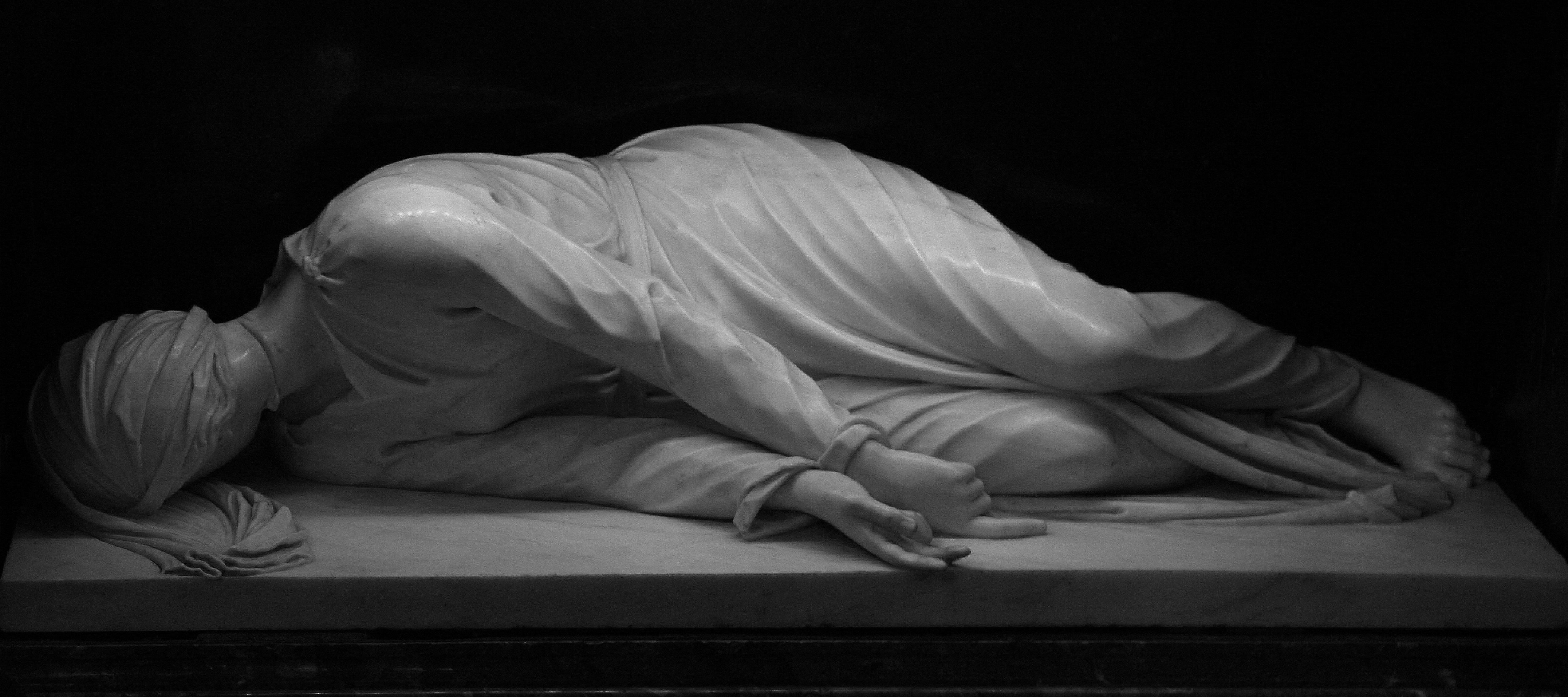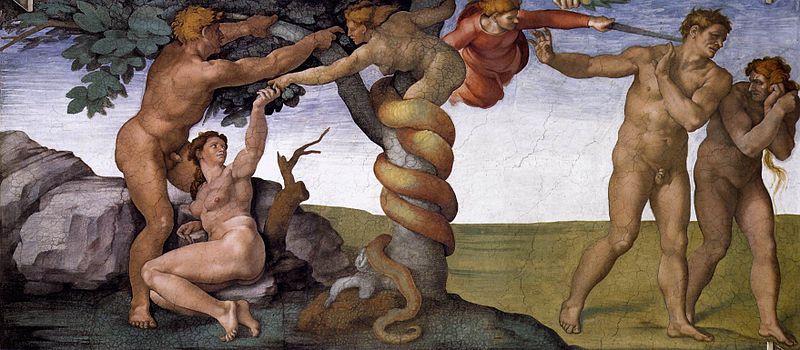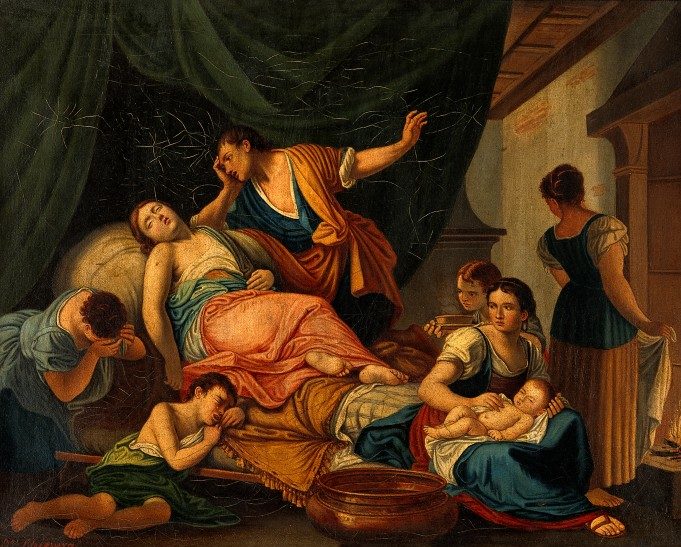The Patient Body
Narratives of Female Pain
“The Patient Body” is a monthly column by Ann Neumann about issues at the intersection of religion and medicine. This month: Telling the story of gender and suffering.

The Martyrdom of Saint Cecilia by Stefano Maderno
By Ann Neumann
“Unto the woman he said, I will greatly multiply thy sorrow and thy conception; in sorrow thou shalt bring forth children; and thy desire shall be to thy husband, and he shall rule over thee.” Genesis 3:16, KJV
In 1999 Phyllis Schlafly, the tireless conservative icon who at long last died in September at the age of 92, gave a talk at University of California, Berkeley, at the behest of the Young America Foundation. After most of the audience had left, Schlafly missed a step when leaving the podium and fell, cracking her hip.
“While I normally never share that part of the story,” Jiesi Zhao, director of the Center for Entrepreneurship & Free Enterprise at Young America Foundation, wrote at The Washington Times six years later, “I felt it appropriate to mention on the occasion of the celebration of her 90th birthday because of what I learned from [Schlafly] that day.” Schlafly remained calm, even smiled and waved goodbye to her hosts, as she was carried out on a stretcher. Zhao, who marvels at the benefit of bringing Schlafly to Berkeley (“the belly of the beast”), explains why the elder woman’s behavior that day was so instructive for women:
In the midst of the chaos and considerable pain caused by the fall, Mrs. Schlafly displayed her mental toughness and grace that has inspired conservative women for generations…. Mrs. Schlafly’s poise in that moment was an unexpected and important lesson for me. That day, unbeknownst to most of those in attendance, showed us the true meaning of being a strong and competent woman.
Truer words have never been spoken of Schlafly, whose considerable labors for her cause—the prolonged subservience of women to the confines of a mythic, “traditional” domestic order—were never fully rewarded by her conservative male counterparts. Real women, unlike those whimpering feminists relentlessly proclaiming the cost of their labors, suffer and toil in silence.
After Schlafly’s death, Corey Robin wrote at Jacobin that Schafly, “was a woman who managed to navigate — and amass — power in a man’s world, all the while denying that that was what women wanted at all.” He points to Catharine MacKinnon’s famous and sympathetic take-down of Schlafly in a 1982 debate about the Equal Rights Amendment. In that exchange, MacKinnon listed Schlafly’s exceptional achievements and qualifications: she had a law degree, had written nine books and “was instrumental in stopping a major social initiative to amend the Constitution just short of victory dead in its tracks,” writes Robin. And all this while raising six kids and getting no purchase with the paternalistic Republicans. MacKinnon concluded, “I charge that the Reagan Administration has discriminated against Phyllis Schlafly on the basis of her sex.” MacKinnon was right; no one can deny that Schlafly was a badass and an example of a warped kind of feminism. Yet Schlafly would have wanted it no other way. Her pride and investment in female rectitude employed a paradigm of suffering that was inseparable from the politics of gender. Thus, it is Schlafly’s resounding message of silent strength in the face of suffering and pain—literal pain, a cracked hip!—that conservative men and women extoll as “the true meaning of being a strong and competent woman.”
To be female means to bear pain: The challenge for women has always been to rewrite the narrative, to upend this equation. Female pain has a rich and old taxonomy; narratives of what women are expected to endure serve a seemingly endless number of social, medical, legal and religious purposes. Identifying them and countering them, decoupling gender from pain (and all of its uses), means tracking those purposes and countering them with new narratives.*
***
Of course the story of women’s pain is also the story of original sin. For tempting Eve, the snake gets a forever in the dirt: “upon thy belly shalt thou go,” says Genesis 3:14. Man, because he “harkened unto the voice of thy wife,” gets a forever of agriculture, working for his bread, pulling “thorns also and thistles” (Genesis 3:18). (Actually, one could quibble that women likely made the bread and pulled a share of the weeds.) Women, in the Bible, get an eternal triple whammy: “sorrow” and pain in childbirth; to be heard, perhaps, but never heeded (Christianized Cassandras?); and the narrow, defining role as “mother of all living” (Genesis 3:20). The pain of childbirth is the punishment for thinking and speaking. Mother of all living sounds grand enough, but if you’re not pregnant or preparing to be so, ladies, you’ve strayed from your course.
Times have changed, you can say, wagging a finger at a two thousand year-old text. And they have, as evidenced by the power of Schlafly’s voice in a male-dominated political movement. It’s worth noting, though, the consistent emphasis on women’s obligation to suffer. Schlafly supported all kinds of pain, the kinds that reinforced the position of her male counterparts: the pain of women who were pregnant and didn’t want to be, or couldn’t afford to be, or were at risk of death; the physical and emotional pain of rape and domestic violence; the oppressed pain of the LGBTQ community. Schlafly wielded pain as a moral cudgel, deployed to maintain the narrow roles of behavior she and her political counterparts interpreted as moral. You venture beyond the hearth, the marriage bed, the modesty of appropriate female clothes, the confines of strict gender-sexual alignment and you are punished. Or, as a woman in my family used to say, “You don’t listen, you feel.”

The Fall and Expulsion from Garden of Eden by Michelangelo
Domestic and maternal labor, however taxing or painful, are, in Schlafly’s formula, what women were made for. A good woman bears pain, like she bears her children, with a smile and a wave. Trying to escape those “traditional” narratives, trying to avoid pain and oppression, deserves painful punishment. A life of pain, then, is the fate of a woman, no matter how good or bad. If only these stories had died with Schlafly.
Acceptance of pain as the natural, the only acceptable, female state has led to a gross disregard for female pain, not only in general culture but in our medical system. Women who want relief from pain are weak, crazy, vain, demanding, un-credible, overly-emotional, not legitimate women, or at least not good ones. Women’s tales of pain often fail to register for doctors, nurses—and even for women themselves. Last fall, in a story called “How Doctors Take Women’s Pain Less Seriously,” The Atlantic shared Joe Fassler’s account of his wife’s undiagnosed ovarian torsion—and the horrifying dismissal she received from medical practitioners when she told them she was in pain. Months later, The Atlantic was still receiving letters from readers which the publication posted online under the title: “Stories of Misunderstanding Women’s Pain.” “Misunderstanding,” when you read the letters, seems all too kind.
Take, for example, Victoria Sawyer who wrote that she had suffered with endometriosis for years; despite seeing female doctors, she found little sympathy. She was often dismissed or made to think it was all in her head. Another writer, Ruth, suffered for 40 years with dysmenorrhea which caused regular cramps, nausea and vomiting until she finally found a doctor who didn’t think her symptoms were psychosomatic. Another unnamed woman wrote in November that she had gained weight and suffered urinary problems. One doctor insisted that she was pregnant, despite her denial. Finally she found a doctor who diagnosed her with stage 1C ovarian cancer. A pregnant woman was admitted to a hospital doubled in pain. Staff refused to give her medication for fear that it would harm the “baby,” and sent her home. Her brother drove her to another hospital where doctors found that her pregnancy was ectopic, a dangerous condition in which the mother’s life is threatened and the fetus’ unviable. To read any one of the letters is heartbreaking, from the gaslighting by doctors (psychosomatic? “all in your head”?), to the resignation of women who have no choice but accept such dismissals. To read these accounts all together, with their expressions of loneliness and excruciation, it’s hard to deny that they signal an epidemic of disregard for female pain.
In his story, Fassler quotes the essayist Leslie Jamison’s “Grand Unified Theory of Female Pain” from the Virginia Quarterly Review.” He quotes:
The pain of women turns them into kittens and rabbits and sunsets and sordid red satin goddesses, pales them and bloodies them and starves them, delivers them to death camps and sends locks of their hair to the stars. Men put them on trains and under them. Violence turns them celestial. Age turns them old. We can’t look away. We can’t stop imagining new ways for them to hurt.
Our fascination with women under duress—as examples of real women, strong women, moral women—serve multiple social purposes. Not only does it keep women in their places, but is often used as a trope for catalyzing male action: damsels in distress. Women suffer so men can be manly. Women aren’t allowed to be healthy, happy, independent, engaged in their own action. It’s as though we’re more relatable if we need something–like a good saving. As though only pain makes women…women. The natural state of female being is pain and suffering—and that suffering maintains a social order and hierarchy that privileges men. Or, as the prevalent tagline of male headship goes in conservative Christian circles goes: Behind every strong man is a good woman.” She’s behind, she’s quiet, she’s subservient, and she suffers without bothering him in his great endeavors.
Take a minute to Google “images of female cancer sufferer” and you’ll get Jamison’s point. Or think of Mary Valle’s 2013 piece for this publication “Death Porn Body Nonsense,” in which she contends that, “Women are never good enough as we are, no matter what we do. Dying bravely seems like the only perfect option for us.” Valle notes the examples of the saints, often young women who are extolled for their purity and stoic endurance in the face of pain.
Even those who don’t abide a subservient moral role for women employ narratives of natural female behavior for the same purposes. Consider Jessi Klein’s widely-shared essay for The New York Times in July, “Get the Epidural,” in which she argues: “It’s interesting that no one cares very much about women doing anything ‘naturally’ until it involves their being in excruciating pain.” Women are never allowed to be their natural selves—without make up, unshaven, uncoiffed—unless they’re giving birth. Then the shaming of selfish women who want medication begins. With such disregard for women’s well being, it can be no wonder that the US maternal mortality rate has doubled since 1990. The good, natural women who don’t risk their well being—and perhaps their lives—we brand as unnatural, bad mothers who risk their child’s life for their own comfort. To be a woman is to be a mother, second to the needs of others, or to be a monster, selfish and unsafe. There is little room in this equation for anything in between; women know this better than anyone, which is why they ignore their own suffering or risk, sacrifice their lives for their families, or go down in shames.
We have all deeply internalized these messages–often in ways that glorify pain, making it noble, instructive or salvational. As a hospice volunteer I regularly encounter elders and caregivers who tell me that pain has a lesson for us. Platitudes surround the ill or old, usually women, like watchful family members: “God doesn’t give us more than we can handle,” “I’m stronger after cancer than I was before,” “Pain is a part of life.” The moral narrative of pain—the price of living, the punishment for sin, a lesson in strength and faith—is pervasive and hard to miss.
***
So what’s wrong with applying a moral narrative to pain? The short answer is: nothing, if it alleviates that pain. We narrate our troubles and triumphs in order to make sense of them, to fit them into our life story. If giving a meaning to your pain makes it easier to bear, why not?
But the long answer is much more complicated. There are all kinds of pain, first of all. And who but the one in pain is to say how much is too much? Also this: If our culture tells women that they must suffer in silence, that pain is their plight, that no one cares what they endure, that propriety and acceptance require that they suffer, even that they become strong and confident women when they suffer, how then can women counter the expectation, the anticipation, of their pain? By changing the narrative. Women have long written against the horrors of disregard, glorification, and moralization of their pain. Sharing and encouraging these narratives works to counter the pain-enforcing ones. It creates community, magnifies voices, and dispels the outsider status of women willing to say they hurt.

V0017250 The birth of Benjamin and the death of Rachel. Oil painting
Credit: Wellcome Library, London. Wellcome Images
[email protected]
http://wellcomeimages.org
The birth of Benjamin and the death of Rachel. Oil painting by D. Chiesura after Giovanni Battista Bettini, called il Cignaroli.
By: Giovanni Battista Bettiniafter: Domenico ChiesuraPublished: –
Copyrighted work available under Creative Commons Attribution only licence CC BY 4.0 http://creativecommons.org/licenses/by/4.0/
In “Monstrous Births,” an essay for The Hairpin, Sarah Blackwood tries to change the pain narrative by pointing us to other narratives, old and new. Blackwood challenges the empowerment narrative (think: power comes from pain) of modern childbirth and reminds us of the tales of the “amoral nature of birth” that brave women have written throughout the centuries:
Mary Wollstonecraft writing to Godwin while in the labor (with Mary Shelley) that would kill her (“I have no doubt of seeing the animal today”), or Harriet Jacobs wishing the children she bore in slavery dead, or the climactic birth scene that Kate Chopin refuses to narrate in The Awakening.
Blackwood is reminding us of the women who have dared to see their labor as something other than redeeming or strengthening, who have pointed to the horror of the adage that “‘all that matters is a healthy baby’ (perhaps the most misogynistic phrase in all of postpartum language).” By not acknowledging the danger and horror that is required of childbirth—and we’re as guilty of it today (with our en vogue “all natural” events, midwives and cases of coconut water in tow) as we were before epidurals—we’re perpetuating the story of the importance of women’s pain. Blackwood writes:
I think contemporary women (especially those who are keyed in to feminist discussions of birth) have a hard time listening to these kinds of stories: when birth is dangerous or wretched we think of it as gone “wrong” and we turn to thinkers like [Guide to Childbirth author Ina May] Gaskin to help us remember to trust the wisdom of our bodies. Bodies do have a sort of wisdom but it’s easy to lose track of how that wisdom is not moral. It’s the stories we tell about bodies that overlay them with moral values.
These narratives of moral pain come in all shapes and sizes—and they are destructive. They are rife with intentions, politics and repercussions; they distract doctors tending to endangered women in our emergency rooms; they influence juries listening to rape testimonies in our courts; they sway legislators who are one signature away from damning countless women to unnecessary and unwanted motherhood for the rest of their lives. Blackwood rightly wants us to liberate women’s pain from these moral narratives because a much more subtle argument about pain is necessary.
Surely some pains are unavoidable: the pain of grief at the death of a grandparent, a broken heart. But what narrative are we morally obligated to apply to those pains that are unnecessary? Anyone, like Phyllis Schlafly, who commits so much labor to the perpetuation and enforcement of the pain of others gives us ample cause to hope there is indeed a judicious God.
When advocates for reproductive justice proclaim, “trust women,” they point us to part of the problem. The writings of women like Klein and Blackwood help by giving new narrative voice to female suffering. Pushing moral justifications for women’s pain, like Schlafly’s biblical endorsements, to the background help too. By divorcing pain from ideas of punishment or unfavorable behavior or even female expectations, we can decouple gender and suffering.
***
* From the August, 2015 “The Patient Body,” “How Ethics Saved the Life of Medicine”: “‘A life story doesn’t just say what happened,’ wrote Julie Beck in a recent article about the power of storytelling, ‘it says why it was important, what it means for who the person is, for who they’ll become, and for what happens next.’ When that person is a patient, the narrative becomes the joint project of both her and her doctor. The accuracy of that narrative determines nothing less than how she lives or when she dies. The practice of discerning illness—of crafting the right narrative—and making accurate prognoses is an ethical act that must weigh the value of life. It must be grounded in a foundational understanding of what our responsibilities are to each other.”
***
Past “The Patient Body” columns can be found here.
***
Ann Neumann is a contributing editor at The Revealer and Guernica magazine and a visiting scholar at The Center for Religion and Media, NYU. Neumann is the author of The Good Death: An Exploration of Dying in America (Beacon Press, 2016).
***
Published with support from the Henry R. Luce Initiative on Religion in International Affairs.